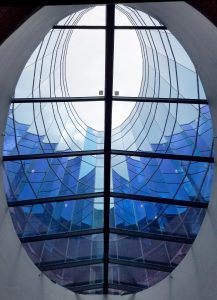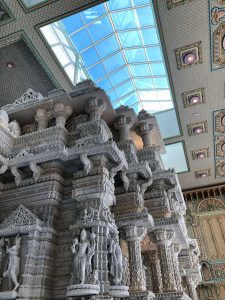Ridge skylights have one ridge along the top of the framework, with two sides sloping up towards that ridge. They may be placed on the ridge of a sloped roof or constructed on a flat roof.
Although traditionally conceptualized as long, narrow apertures, contemporary ridge skylights break such limitations. They can be engineered into various dimensions and configurations to accommodate a wide variety of roofing structures and design requirements. Thus, they can create special solutions in commercial applications, from large-scale distribution centers to multilevel office buildings.
There are four types of ridge skylights:
- Standard ridge: May be with or without gabled ends
- Saddle ridge: Sits atop the roofline of a structure
- Barrel ridge: Features a curved top that allows one to see the sky above clearly without obstructions
- Double-pitch or Hipped ridge: Has two sloping ends that meet at the center ridge of the skylight
Ridge skylights work well with various roof types, providing both functional and aesthetic benefits. Here are a few examples:
- Pitched Roofs: Ridge skylights integrate perfectly with pitched roofs. The saddle style is installed along the roofline, matching the pitch of the roof and providing seamless integration into the existing rooftop.
- Flat Roofs: For flat roofs, a standard ridge skylight can be used to allow natural light into the building. Such skylights are made according to size or pitch.
- Custom Roof Designs: For special architectural designs, custom ridge skylights are engineered for unique applications. This also involves adjusting to different pitches, sizes, and shapes of roofs so that the skylight fits seamlessly into the design.
- Structural Ridge Skylights for Large Roof Openings: In buildings with large roof openings, structural ridge skylights can span very long distances. With custom glazing type and color, control of heat and glare can be based on building orientation.
Installation of ridge skylights can significantly reduce dependence on artificial lighting. However, the net energy impact differs greatly depending on several factors, including climatic conditions, building orientation, and thermal properties of the chosen skylight system. A detailed approach to energy modeling is necessary to accurately predict potential savings and achieve optimized design.
Key Features of Ridge Skylights:
- Glazing Options:
- Can accommodate different types of glazing materials, including glass, multiwall polycarbonate, and BIPV (Building Integrated Photovoltaics)
- Offers energy-efficient models that comply with IECC energy codes
- Frame Material:
- Constructed from high-quality aluminum, ensuring durability and structural integrity
- Available in custom powder coat and Kynar finishes that meet AAMA 2604 and 2605 standards
- Thermal Performance:
- Features thermal strut technology for enhanced thermal performance and better condensation resistance
- Fully tested for air, water, and structural performance per ASTM E-283, ASTM E-300, and ASTM E-331 standards
- Design Integration:
- Can integrate with doors, windows, operable vents, and custom cladding
- Suitable for large-span applications, providing flexibility in architectural design
- Installation and Customization:
- Available in pre-assembled options for quick lead times and simple installation
- Can be designed to fit any roof pitch and nearly any size, making them suitable for a wide range of projects and applications
For architects, material selection for ridge skylights has undergone dramatic development to include a host of high-performance options. Besides basic glass and polycarbonate, advanced glazing technologies available for use in skylights include low-emissivity coatings and electrochromic glass. These provide dynamic control over solar heat gain and glare—two critical factors in maintaining comfortable, energy-efficient commercial environments.
Skylights, being on top of the roofing structure, require extra special care for their waterproofing and thermal performance. Proper detailing in integrating them with the building envelope will avoid the potential for leaks and help protect overall integrity. Long-term performance should be ensured by utilizing experienced manufacturers and installers, reducing the burden of maintenance.
Ridge skylights truly excel in large commercial applications. They represent a refined way of letting light into large interior volumes such as terminals, convention and exhibition centers, schools, and other learning facilities. By reducing the need for artificial lighting during daylight hours, they contribute to energy conservation.
In the growing trend of commercial construction toward sustainable design and occupant well-being, ridge skylights stand as a solution that addresses many challenges facing architects and builders. Ridge skylights combine aesthetic appeal with functional advantages, providing an effective tool for creating light-filled, energy-efficient commercial spaces that meet the needs of modern businesses and their occupants.
Done thoughtfully, ridge skylights do a lot more than merely let in light; they raise the entire architectural concept to the next level, shifting commercial roofscapes into dynamic systems using natural light to its fullest potential. As we press boundaries in commercial design, these innovations from up high are sure to play a very key role in shaping a brighter and sustainable future for the built environment.



